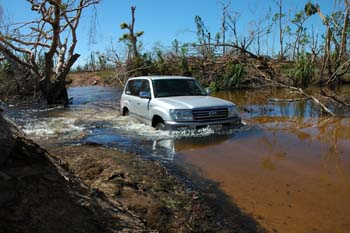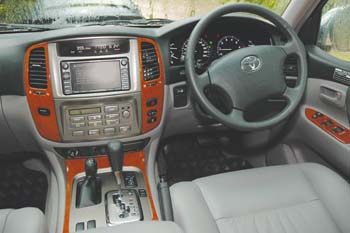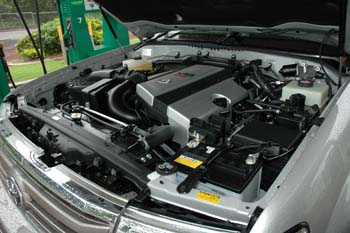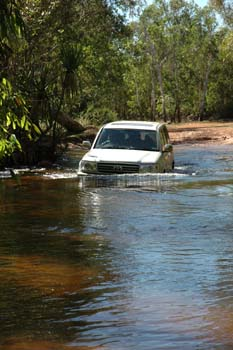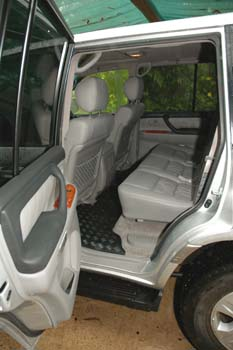Toyota Landcruiser 'Sahara'
- NAFA
- Jul 1, 2007
- 12 min read
Updated: Apr 2, 2020
Dick takes AJ’s new wheels for a spin around the block — Top End style.
“Use it and test it while you’re in Darwin,” said Alex Julius, handing me the key to his brand new Toyota Sahara Landcruiser. I protested, but he insisted, so for the next few days I used the luxury vehicle on my latest Top End fishing excursion.
With only 200 kilometres on the clock, this vehicle was pure showroom stuff and I managed to push the speedometer pass the 400 kay mark before Alex got the key back. Unfortunately, the start of the wet season proper (at the end of March no less!) prevented me giving the Sahara a true off-road test.
The late Wet was a blessing though, as the floodplains badly needed topping up after a long lull in monsoonal activity, though they really got a soaking when Queensland send Cyclone Monica over a weeks later.
The Landcruiser
The Landcruiser has been Toyota’s flagship for over half a century and shows no signs of slowing down. The current model, the 100 Series, has been the most successful, with three models in the range — Standard, GLX and the Sahara. I have had a GLX since they first appeared in 1998 and have put 200,000 kilometres on the clock. It has been very reliable, with only service parts needing attention — wheel bearings, kingpins, hoses, belts and suspension. This model was first available in a naturally aspirated 4.2 litre diesel, a 4.7 litre V8, and the legendary 4.5 litre six cylinder. The V8 was dropped in 2000 due to lack of sales and because it was outperformed by the 4.5 litre engine. It was replaced by the popular 4.2 litre turbo-diesel.
However, that all changed with the 2003 range launch and a re-vamped 100S Landcruiser was launched onto the 4WD market. The long-serving 4.5 litre petrol motor was dropped as it failed to meet future exhaust emissions regulations, and was replaced by the 4.7 litre Quadcam multi-valve V8 petrol engine. Also introduced was the IFS (Independent Front Suspension) system. The only non-IFS option is the naturally aspirated 4.2 litre diesel in the standard model.
The V8 engine was derived from the Toyota inspired Lexus LX470 and the original 100 Series GXV. The IFS suspension, which is the same as the Lexus, replaced the rigid front-end system. Power is delivered to the front and rear differentials by a five speed manual gearbox, and a new five speed automatic gearbox.
Toyota also resurrected the Sahara name. There was also some minor restyling inside and out and other extras to entice the buying public. The Sahara is now the top of the range Toyota Landcruiser.
Improvements
Replacing the old four speed automatic gearbox with a new five speed box was a welcome improvement, as the old box used lots of power and the shift was very rough. The five speed box does not have a sequential-shift alternative to ‘Drive’. Instead, the floor lever follows a wriggly track in an open slot.
The Sahara has many mechanical and electrical aids that include locking centre diff, ABS-based electronic traction control, and on-road stability. A cable throttle limits the Sahara to a locking diff, operated with a twist knob on the lower dashboard. In line with other 100 Series Landcruiser models, it has ABS and ventilated disc brakes — front and rear — that help to slow down the spin of the big 17 inch alloy wheels, fitted with Dunlop Grand Trek rubber.
The Independent Front Suspension (IFS) variants have variable ratio gearing on the rack and pinion steering, which provides better feel at low and high speed and is very positive in operation. It gives a better tighter steering circle, and has more lock-to-lock than the rigid axle model reticulated ball setups.
The external items — grill, tail-lights, front and rear bumper, badges and decals, are different to the GLX model. Toyota has been using new bumper materials since the 2003 launch, reputed to be tougher than previous models. Front-on protection is spot on, as is detail to other improvements. Graphite-coated windscreen wiper blades, improved rear screen washers, revised seat belt webbing and slip joints, air cooling ducts to keep air conditioning in the cabin and dust out, tail light and brake lamp failure warnings, and better impact padding in the pillars and roof rails set the Sahara apart from its siblings.
The Interior
The interior is also different in the Sahara. Like the GLX, air conditioning is standard, with the well laid-out center dash providing quick-glance viewing during driving conditions. However, the Sahara also has separate air-conditioning controls and vents for the rear of the vehicle. The heating, ventilation and air conditioning controls are easy to operate, though very different to my GLX Landcruiser, and I had to study the handbook for instructions. It has an automatic climate control option, which quickly cools the cabin before it adjusts itself to the required temperature.
The trim finish is excellent and not overdone, while the power windows all have one-touch automatic lowering and electrical door locks. There are power front seats, wood grain console, power moon roof (great for spotlight shooting) and a refrigerated cooler box.
The Sahara is fitted with a one-touch sensitive 6 1/2 inch screen for the Audio Visual Navigation (AVN) System, which incorporates DVN-based Satellite Navigation with AM/FM MP3 compatible in-dash four disc CD changer. The full-colour screen also displays a premium 35 watt four channel sound system, and the climate control. The folding screen reveals the 4-stack CD head unit, as well as the navigation map DVD.
I am no fan of TV screens in vehicles as drivers who fiddle with settings when mobile are dangerous to themselves and other road users. That’s why I believe it’s a good thing that the vehicle should be stopped before settings are entered.
The GPS navigation system is awesome and with proper maps you can drive anywhere without becoming lost. The radio/CD system is simply outstanding, with pure sound coming all about, no matter where you are sitting. It has enough ‘oomph’ to blast you out of the vehicle if you are that way inclined.
The climate control system has front seats and second row control, with third row ceiling ducts (except the diesel). The Sahara system ensures that air is circulated right around the spacious cabin.
The interior has space for up to 8 passengers, though the removable rear seats are better suited to three small children, not adults, though two average size adults have no problems fitting in. There is no head rest for the centre rear-most passenger. When the rear seats are removed, a huge storage space becomes available. Should you need more, drop the second row of seats down. The leather upholstery gives the vehicle a clean, expensive look that matches that of the exterior.
On The Road
The V8 certainly makes this vehicle truly perform on the black top. If you want to burn off boy racers at traffic lights, the Sahara will do it. Even though the motor was new, it responded immediately when the accelerator was kicked down hard, with the five speed auto smoothly shifting through the gears.
Cruising on the open road is smooth and silent, with little road noise. At 100 km/h the vehicle hugged the road, with no roll or wandering. This incredible cruising vehicle has all the comforts of home. On a long drive, the seats are pure luxury for both passengers and driver.
The Sahara has no noticeable under-steer and has a soft ride, due to its front torsion bar IFS system. The well-valved shocks give the big vehicle a very comfortable ride and great road manners, which is also apparent on bush roads, and you can actually vary the rigidness of the suspension according to load and road conditions.
In traffic, it handles well and responds instantly, while parking the huge beast is no problem. Visibility over the bonnet and all about is excellent, as is expected when you are sitting up high.
Braking with the ABS system is excellent on bitumen and it responds quickly and pulls up well when the anchors are brought into play. From personal experience I would like to have the option to switch the ABS system off when driving on gravel surfaces, as the lockup can be too abrupt, resulting in long hard skids that are difficult to control (though this is open to argument because conditions differ so much when dirt driving). One thing about the Sahara, it is more car-like to drive than other 4WDs of comparable weight and size.
On Bush Tracks
The rain didn’t stop for 10 days and heading off-road in the Top End is not on the cards under such conditions. Besides, I am not in the business of wrecking vehicles, especially ones that don’t belong to me! However, I did find some good bush tracks that were reasonably hard though full of potholes on the Howard Springs Nature Reserve and the Howard River boat ramp road.
The GLX and the Sahara are full-time four wheel drive vehicles that have fantastic road holding ability (especially on dirt roads), and with diff locks front and rear there is little these 4WDs can’t handle in the bush. At speed, the shock and springs/torsion bars did a fantastic job and prevented bottoming out in all situations. The system soaks up the bumps and gives full control to the driver in harsh conditions.
The Sahara performed as expected in the mud and slush, creeping up over rocks, through muddy creeks, potholes and through slippery mud with ease. I love the automatic gearbox in the bush, as full attention with both hands on the steering wheel is possible. There is no required gear changing as such, everything is done for you. Locking the vehicle into a chosen gear or low range is simple. For instance, when towing in tough conditions, locking the gear into low range third high is as simple as moving two levers into position.
4WD and motoring magazines often make comments when testing new vehicles that it could not climb such-and-such a hill, bogged down in sand dunes, and slewed all over the place in muddy conditions. These comments are fair enough because they are written about a new vehicle and conditions as found. However, in true everyday use, the vast majority of 4WD owners don’t push their expensive investment to the limit because they want to protect it, can’t afford repairs, or have no reason to go where motoring writers do.
One thing that has motoring writers talking is the IFS system, which many maintain fails to match the equivalent rigid axle system on rough tracks. To some extent this is true, but only if you want to thrash the guts out of your GLX or Sahara. Buy what you need — a superb family cruising wagon, or a scrub-bashing 4WD. For the latter, the Landcruiser trayback is a far better choice, and if you need extra passenger space, the standard model fits the bill.
It is true that it is not as good as the live-axle model on the early GLX and current standard models, but it makes up for it on the open road with better stability, feel, and handling, and let’s face it, most travel is on the black top.
There are many standard GLX and Sahara models towing camper and boat trailers to Cape York, the Gulf Country, Arnhem Land and the Gibb River road, with few or no modifications. Few owners have any complaints about the IFS system under those conditions, probably because they have grown up with it and, most importantly, don’t thrash the vehicle.
The Active Traction Control system on the Sahara tames the spinning effect of the four wheels when the vehicle is pushed hard on slippery dirt roads, as it controls the output of the brake and engine. The system gives the driver a hand to control the driving power of the four wheels and comes into play when the ignition key is engaged. It is a great help as it prevents skidding under adverse conditions.
Active Height Control (AHC)
The AHC controls the vehicle’s height depending upon the road conditions. It has three settings — ‘HI’ (High), ‘N’ (Normal), and ‘LO’ (Low) modes. At ‘HI’ the vehicle height is about 40 millimetres higher at the front and 50 millimetres higher at the rear than in ‘N’ mode. This mode is suitable for rough roads and deep-water crossings, but only at a speed below 30 km/h. If it exceeds this speed, normal mode is automatically selected.
When four-wheel drive ‘LO’ mode is used at 50 km/h the height control is set automatically about 25 millimetres higher than normal (‘N’) mode height. If the vehicle becomes bogged, the height will rise by itself to extra height mode of about 70 millimetres.
AHC is a remarkable system that automatically (and manually) sets the required height control for safe driving conditions, regardless of the number of passengers or load in the vehicle. However, if the load capacity exceeds the recommended limits, the vehicle can’t be raised. In other words, like a good horse, it goes on strike if the load is too heavy for safe carrying.
To change the vehicle’s height the engine must be running, all doors closed, and the height control indicator tuned off. When the vehicle is jacked up to change a tyre, the AHC controls must be switched off and the engine stopped.
However, there is more to this remarkable on/off road vehicle. The Skyhook Toyota Electronic Modulating Suspension (TEMS) controls the fine adjustment of the shock absorbers with a dampening mode select switch. The switch is set for conditions encountered — corrugated/dirt road, ordinary city road driving, moderate high speed, and windy mountain roads at high speed.
You could be forgiven for thinking that this is overdone, and yes, you will need to get out there with the instruction book and find how it all works, but when it all comes together you appreciate what this vehicle is all about.
The Bits
The huge V8 engine fills the engine bay and there is little room for anything else, including a spare battery, standard with the turbo diesel model. There is room to fit one, but some work detail is needed. The engine bay has good access to levels.
Grease nipples are in the drive shafts to service the universal joints. The IFS system with CV joints is just a bit more difficult to service than the live axle version. However, in all the GLX/Sahara series service and maintenance is relatively simple to do yourself.
There are two fuel tanks that hold a combined 143 litres.
Accessories
The IFS Landcruiser has an extensive list of after-market products and there is a huge range of accessories available, either from Toyota or specialist outlets like ARB and others. Bullbars, sidebars, hood racks, driving lights, sun protectors, dust screens, and more can be added to give your new vehicle cosmetic appeal, or improve its pure bush use.
The Sahara in Arnhem Land
I was back in Arnhem Land in June. Weeks before Alex had shipped the Sahara by barge to Maningrida and then on to the Arnhemland Barramundi Nature Lodge. At the time, Maningrida was inaccessible by road. Anyway, we decided to drive it back to Darwin via Kakadu, a journey of 500 kilometres, half over a dirt road partly destroyed by the fury of Cyclone Monica only weeks before. NAFA’s advertising manager, Suzanne Marsh, was also on board.
Monica is billed as the biggest-ever tropical storm to hit the Australian mainland. She was huge, but also kind, as she did little damage to the puny hovels of human beings, missing all the major settlements on her slow, ponderous path from the Coral Sea and across the Cape York Peninsula before losing her identity in Arnhem Land.
Rivers were high and a work party was clearing the road. We used a tarpaulin over the radiator grill to cross the Mann River, but didn’t really need it. The Liverpool River was also deep and I kept a wary eye open for crocodiles as I waded across to test the depth and for photos. The water was deep enough to wet the budgie.
Some time later, we began to see the foliage damage that the cyclone had caused and soon we were awestruck by the power of the winds. Valley to valley and ridge to ridge showed only smashed tree trunks that had been torn from the damp ground, and twisted off their foundations. It was an alien and unknown landscape, as we saw escarpments that we never knew were there as the old growth monsoon woodlands prevented us seeing them in the past. Apart from a few birds, the only live animals we saw were four brumbies near Tor Peak.
The 300-year old paperbarks that once shaded the King and Goomadeer Rivers had been pulled from the ground and smashed. Little greenery was evident and it will take years for this country to recover — if ever. Even the escarpments looked as if someone had gurnied them with a high pressure hose.
The rivers and creeks were running high, but the Sahara with its AHC made the crossings easy — too easy in fact, as I wanted photos of the bonnet under water, but the nose just kept rising above the level and the engine did not miss a beat. As the Sahara is not fitted with an air snorkel, we had some reservation about water crossings, though all electrics were sprayed with WD-40.
The road was washed out in many places, while all stream crossings were bad. In some sections, swamp waters still backed up over the road, thus it was never easy driving. However, we all felt that by the time we crossed the tidal waters of Cahill’s Crossing on the East Alligator River and onto the bitumen road to Darwin, the Toyota Sahara had done itself proud.
With over 4000 kilometres on the clock, the vehicle was put through its paces on the Arnhem Highway and I sat the speedo at a healthy pace on the straight stretches. The Sahara hugged the road in comfort with no vibrations, wanderings, or slewing being noted. As in the Arnhem Land wilds, it handled the black top with ease and comfort, and at day’s end we were more than impressed by the performance of this thoroughbred from the Toyota stables. It will win any race.
Summary
The Sahara is a true long-range touring vehicle that has all the comforts needed to head around Australia, or into the bush for the weekend. It handles well in heavy city traffic, responds immediately, and is easy to park, with excellent visibility.
Make no mistake, the GLX and Sahara might have moved into town, but out in the bush they are still Toyota Tough — the only thing being different between them and the standard Landcruiser is that you get to drive to your destination in more comfort.
The Sahara is a fantastic tow vehicle, which makes passing others on the road while towing easy. Besides, the AHC can be used to jack the tow bar up to the required height, instead of winding the jockey wheel up. How good is that?





